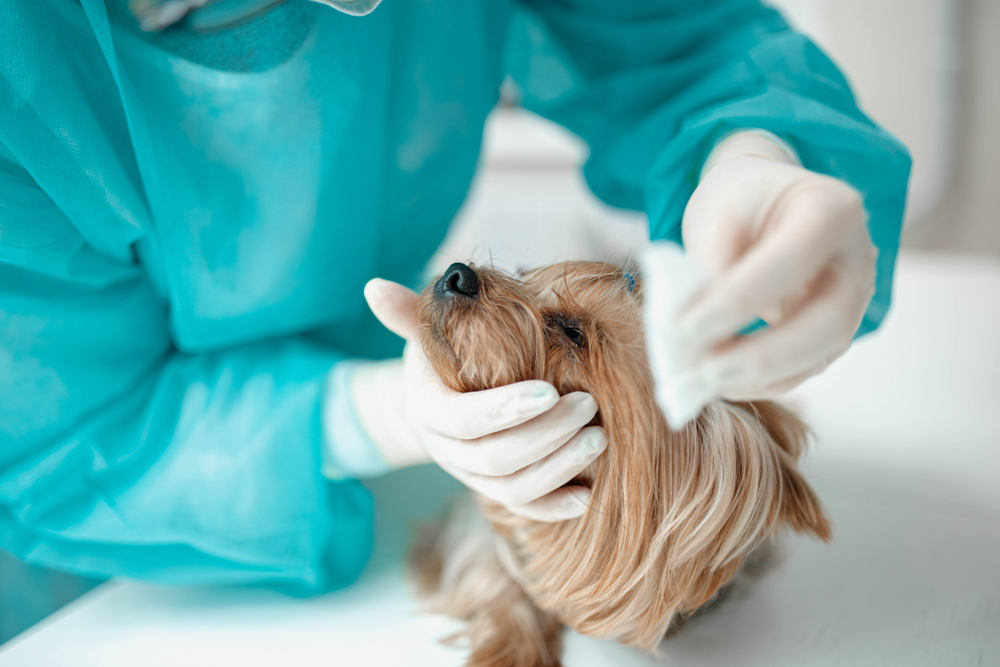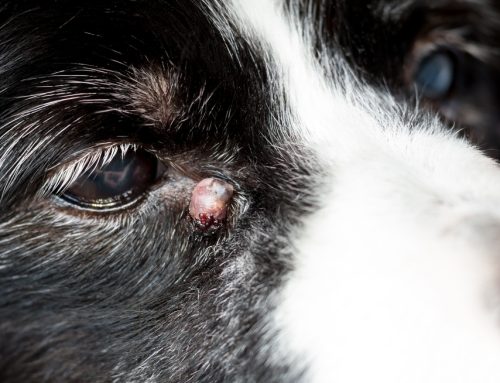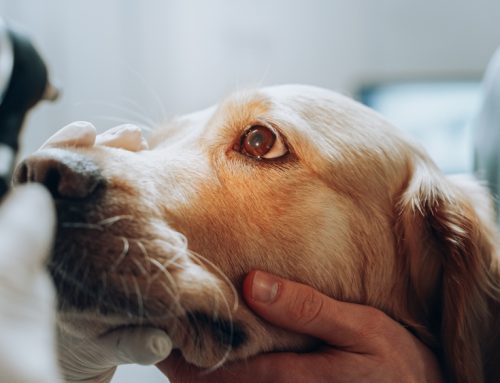You know having a hair or eyelash in your eye can be extremely uncomfortable. Now, imagine the discomfort you would experience if the annoying hair could not be blinked or rinsed away. Abnormal hair growth near or on—yes, you read that correctly—a pet’s eye can cause persistent irritation, corneal ulceration and scarring, and vision changes. Our Veterinary Vision Center team outlines the different types of aberrant ocular hair growth, how they can affect your pet’s vision, and treatments for each.
Ectopic cilia in pets
An ectopic cilia is an eyelash or hair that grows in an abnormal location. For example, an ectopic cilia may grow under your pet’s eyelid rather than outside the eyelid, arising from the conjunctiva, or pink tissue lining the eyelids. This abnormal hair constantly contacts the cornea, and causes persistent irritation, which can lead to a corneal ulcer. Ulceration may also result from a pet pawing at their eye to relieve discomfort. Ectopic cilia typically occur singly, and can sometimes be identified by everting a pet’s eyelid and examining the conjunctival membrane. The abnormal hairs are often fine, however, and may need magnification for diagnosis.
Trichiasis in pets
Trichiasis describes hair near a pet’s eye that grows in such a direction that the hair contacts the eye surface. Trichiasis most commonly occurs near the medial canthus, or inner corner, of the eye from hair growing deep inside the eye’s corner. This condition is diagnosed most commonly in brachycephalic (i.e., short-nosed) breeds, such as pugs, shih tzus, and Boston terriers. As with ectopic cilia, the hair’s constant contact irritates the cornea, and can lead to ulceration and scarring.
Distichiasis in pets
Distichia are abnormal hairs that grow from meibomian glands on a pet’s eyelid margin. These hairs rub against the cornea each time the pet blinks, causing chronic irritation. Pets often have several hairs growing together, and the abnormal hairs are typically finer than normal eyelashes, which can make diagnosis challenging.
Dermoids in pets
The most bizarre type of abnormal ocular hair growth is a dermoid, or a true “hairy eyeball,” where a patch of displaced skin, including hair, grows on the eyeball, appearing as an island of haired skin on the smooth eyeball surface. The abnormal hairs can rub against the corneal surface and eyelid conjunctiva, irritating both structures.
Abnormal hair growth signs in pets
Any pet with persistent ocular inflammation should be examined for possible aberrant hairs that are contacting the corneal surface and causing chronic inflammation. Pets with ocular irritation typically display signs such as:
- Redness
- Tearing
- Blinking
- Squinting
- Pawing at the eye
- Vessels growing on the corneal surface
- An abnormal corneal appearance
If your pet displays ocular inflammation signs, have them evaluated immediately. Your family veterinarian may be able to identify abnormal hair growth, or they may refer your pet to Vision Veterinary Center’s board-certified veterinary ophthalmologist, Dr. Kenneth Pierce.
Abnormal hair growth diagnosis in pets
An ectopic cilia, trichiasis, distichiasis, or dermoid diagnosis is based on a thorough ocular examination. Some hairs, such as ectopic cilia and distichia, may be difficult to identify, since they tend to be finer than normal hair, or located where examination is difficult. In addition to locating the aberrant hairs, your veterinarian will evaluate your pet’s cornea for damage, including ulceration and scarring. Fluorescein stain will likely be used to diagnose corneal ulcers, and assess their extent.
Abnormal hair growth treatment in pets

Treatment is designed to prevent ongoing ocular irritation, and will depend on the location of your pet’s abnormal hair growth. Following your veterinarian’s orders carefully to manage your pet’s condition is critical to prevent lifelong eye irritation, corneal scarring, and vision impairment. Some conditions require that the abnormal hair follicles be surgically removed to prevent regrowth, whereas other conditions may require plucking the hairs or keeping them trimmed short to prevent ocular contact. Here are common treatment strategies, according to each condition:
- Ectopic cilia — Surgery is often performed to permanently remove abnormal hair from the conjunctival surface.
- Trichiasis — In some patients, hair growing in an abnormal direction can be kept short to prevent ocular contact. Other patients require surgical removal of hairs growing toward the eye.
- Distichiasis — Hairs growing from the eyelid margin require regular veterinary management, and typically are plucked every four to six weeks.
- Dermoids — Dermoids require surgical removal. Since they grow on the corneal surface, excision involves removing only a thin layer of corneal cells, which will grow back with minimal scarring.
If you notice any ocular abnormalities in your pet, contact our team at Veterinary Vision Center for expert eye care. Your pet’s eyesight is precious, and we will work with you to manage their condition, and preserve their vision throughout their life.







I loved the post, keep posting interesting posts.